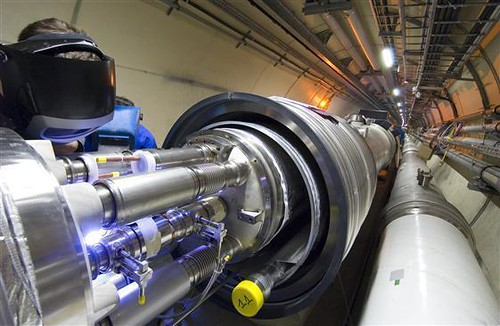Large Hadron Collider
You’ll love this video, "Large Hadron Rap," explaining CERN’s large hadron collider in Switzerland…

What it is:
The Large Hadron Collider (LHC) is a gigantic scientific instrument near Geneva, where it spans the border between Switzerland and France about 100 m underground. It is a particle accelerator used by physicists to study the smallest known particles – the fundamental building blocks of all things. It will revolutionise our understanding, from the minuscule world deep within atoms to the vastness of the Universe.
Two beams of subatomic particles called ‘hadrons’ – either protons or lead ions – will travel in opposite directions inside the circular accelerator, gaining energy with every lap. Physicists will use the LHC to recreate the conditions just after the Big Bang, by colliding the two beams head-on at very high energy. Teams of physicists from around the world will analyse the particles created in the collisions using special detectors in a number of experiments dedicated to the LHC.
There are many theories as to what will result from these collisions, but what’s for sure is that a brave new world of physics will emerge from the new accelerator, as knowledge in particle physics goes on to describe the workings of the Universe. For decades, the Standard Model of particle physics has served physicists well as a means of understanding the fundamental laws of Nature, but it does not tell the whole story. Only experimental data using the higher energies reached by the LHC can push knowledge forward, challenging those who seek confirmation of established knowledge, and those who dare to dream beyond the paradigm.
CERN had the world’s first Web site, and today’s "firing up" was a success, via Science Daily:
An international collaboration of scientists today sent the first beam of protons zooming at nearly the speed of light around the world’s most powerful particle accelerator—the Large Hadron Collider (LHC)—located at the CERN laboratory near Geneva, Switzerland. The U.S. Department of Energy (DOE) and the National Science Foundation (NSF) invested a total $531 million in the construction of the accelerator and its detectors, which scientists believe could help unlock extraordinary discoveries about the nature of the physical universe.
Celebrations across the U.S. and around the world mark the LHC’s first circulating beam, an occasion more than 15 years in the making. An estimated 10,000 people from 60 countries have helped design and build the accelerator and its massive particle detectors, including more than 1,700 scientists, engineers, students and technicians from 94 U.S. universities and laboratories supported by DOE’s Office of Science and NSF.“As the largest and most powerful particle accelerator on Earth, the LHC represents a monumental technical achievement,” said U.S. Department of Energy Undersecretary for Science Raymond L. Orbach. “I congratulate the world’s scientists and engineers who have made contributions to the construction of the accelerator for reaching this milestone. We now eagerly await the results that will emerge from operation of this extraordinary machine.”
This really is big news. I found Stephen Hawking’s opinion interesting:
"Together they [the LHC and the space program] cost less than one tenth of a per cent of world GDP. If the human race can not afford that, then it doesn’t deserve the epithet ‘human’."
Here’s the AP video, with good background…
And here’s the Reuters clip of the joyous moment…